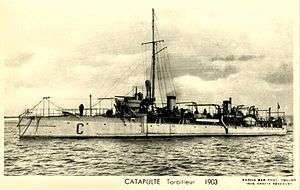French destroyer Catapulte
 Catapulte at anchor | |
| History | |
|---|---|
| Name: | Catapulte |
| Namesake: | Catapult |
| Ordered: | 1901 |
| Builder: | Forges et Chantiers de la Méditerranée, La Seyne-sur-Mer |
| Laid down: | 1901 |
| Launched: | 1 April 1903 |
| Fate: | Sunk in collision 18 May 1918 |
| General characteristics | |
| Class and type: | Arquebuse-class destroyer |
| Displacement: | 323 t (318 long tons) |
| Length: | 58.26 m (191 ft 2 in) (o/a) |
| Beam: | 6.38 m (20 ft 11 in) |
| Draft: | 3.2 m (10 ft 6 in) |
| Installed power: |
|
| Propulsion: | 2 shafts; 2 Triple-expansion steam engines |
| Speed: | 28 knots (52 km/h; 32 mph) |
| Range: | 2,300 nmi (4,300 km; 2,600 mi) at 10 knots (19 km/h; 12 mph) |
| Complement: | 60 |
| Armament: |
|
Catapulte was one of 20 Arquebuse-class destroyers built for the French Navy in the first decade of the 20th century. She saw service during World War I.
On 11 May 1918, Caiatpulte assisted several other ships in rescuing the survivors of the French troopship Sant Anna, which was carrying 2,025 troops when she was torpedoed and sunk in the Mediterranean Sea with the loss of 605 lives by the Imperial German Navy submarine SM UC-54 26 nautical miles east of Cape Bon, French Tunisia.
On 18 May 1918, Catapulte collided with the British steamer Warrimoo and sank in the Mediterranean Sea off Bône, French Algeria.[1][2]
References
- ↑ "Major Warships Sunk in World War 1 1918". World War I. Retrieved 24 February 2013.
- ↑ "French Navy". Naval History. Retrieved 21 February 2013.
Bibliography
- Chesneau, Roger & Kolesnik, Eugene M. (1979). Conway's All The World's Fighting Ships 1860–1905. London: Conway Maritime Press. ISBN 0-85177-133-5.
- Couhat, Jean Labayle (1974). French Warships of World War I. London: Ian Allen. ISBN 0-7110-0445-5.
- Gardiner, Robert & Gray, Randal (1985). Conway's All The World's Fighting Ships 1906–1921. London: Conway Maritime Press. ISBN 0-85177-245-5.
This article is issued from Wikipedia - version of the 9/30/2016. The text is available under the Creative Commons Attribution/Share Alike but additional terms may apply for the media files.
